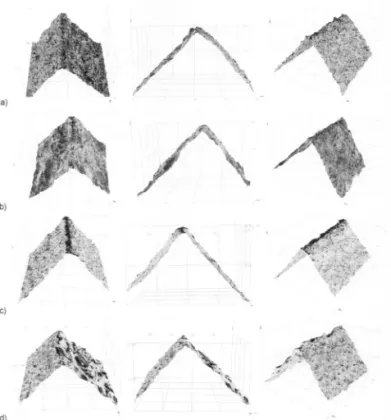Science Arts & Métiers (SAM)
is an open access repository that collects the work of Arts et Métiers Institute of Technology researchers and makes it freely available over the web where possible.
This is an author-deposited version published in: https://sam.ensam.eu Handle ID: .http://hdl.handle.net/10985/19690
To cite this version :
M. GOBCZAK, P. MAKSIM, Philippe JACQUET, A. GOBCZAK, K. WONIAK, Corinne NOUVEAU - Investigations of geometrical structure and morphology of samples made of hard machinable materials after wire electrical discharge machining and vibroabrasive finishing
Investigations of geometrical structure and
morphology of samples made of hard machinable
materials after wire electrical discharge machining and
vibro-abrasive finishing
Untersuchung der Oberfla¨chenstruktur und Morphologie von
schwer zu bearbeitenden Metalllegierungen nach elektroerosivem
Drahtschneiden und Vibrationsschleifbearbeitung
M. Goła˛bczak1, P. Maksim1, P. Jacquet2, A. Goła˛bczak3, K. Woz´niak4, C. Nouveau5
In this article the results concerned influence of processing conditions of the wire electrical discharge machining and vibro-abrasive machining on the surface layer and morphology of samples made of hard machinable materials used in aircraft in-dustry like: Titanium 5553 b, Inconel 617, Hastelloy X and Magnesium AZ31 have been presented. For this purpose the cubic and cylindrical samples made of hard machinable alloys have been prepared using optimal electric parameters of wire-cut electrical discharge machining and finally they have been polished using circu-lar vibratory finishing technology and different ceramic shaped stones.
Keywords: Wire electrical discharge machining / circular vibratory surface finishing / ceramic shaped stones / hard machinable alloys / surface geometrical structure / surface roughness
Im Artikel werden Untersuchungsergebnisse von schwer zu bearbeitenden Metall-legierungen aus der Flugzeugindustrie nach dem Einsatz von elektroerosivem Drahtschneiden und der Vibrationsschleiftechnik in Bezug auf Rauheit und Oberfla¨-chenstruktur dargestellt. Zu diesen geho¨ren: Titan 5553 ß-Legierung, Inconel 617, Hastelloy X und Magnesium AZ31-Legierung. Zu diesem Zweck wurden Proben in Wu¨rfel- und Zylinderform mit elektroerosivem Drahtschneiden ausgeschnitten und
Corresponding author: M. Goła˛bczak, Institute of Ma-chine Tools and Production Engineering, Lodz Univer-sity of Technology, Stefanowskiego 1/15 Street, 90-924 ŁO´ DZ´, REPUBLIC OF POLAND,
E-Mail: marcin.golabczak@p.lodz.pl 1 Institute of Machine Tools and Production
Enginee-ring, Lodz University of Technology, Stefanowskiego 1/15 Street, 90-924 ŁO´ DZ´, REPUBLIC OF POLAND 2 E´ cole Catholique des Arts et Me´tiers, 40 Monte´e Saint-Barthe´lemy, 69321 LYON, FRENCH REPU-BLIC
3 Higher Vocational State School in Włocławek, 3 Maja 17 Street, 87-800 WŁOCŁAWEK, REPUBLIC OF POLAND
4 MARBAD Ltd. Company, Kulczyn´skiego 14 Street, 02-777 WARSZAWA, REPUBLIC OF POLAND 5 Arts et Me´tiers Paris Tech, Rue Porte de Paris,
mittels der Vibrationsschleiftechnik unter Anwendung von keramischen Schleifmit-teln fertigbearbeitet.
Schlu¨sselwo¨rter: Elektroerosives Drahtschneiden / Fertigbearbeitung mit Vibrationsschleiftechnik / keramische Schleifmittel / schwer zu bearbeitende Metalllegierungen / geometrische Struktur der Oberfla¨che / Oberfla¨chenrauheit
1 Introduction
In this article the investigation results concerning es-timation of the conditions of the wire electrical dis-charge machining (WEDM) process and vibro-abra-sive machining on the surface layer, roughness and morphology of machined aerospace alloys like Mag-nesium AZ31, Hastelloy X, Inconel 617 and Tita-nium 5553 ß are presented. The AZ31 magnesium alloy is characterized by very low density (1.8 g/ cm3), has very low hardness (70 HB) and tensile strength (350 MPa). The melting point of AZ 31 magnesium alloy is only 600 8C. Mg alloys are used where weight reduction is necessary, i. e. in motori-zation and aeronautics. The titanium 5553 beta alloy has higher density (4.6 g/cm3) and hardness (370 HB) and has extremely high tensile strength (1350 MPa). The melting point of titanium beta alloy is also very high, at 1670 8C. Titanium alloys are used in production of many parts of planes and medi-cal implants. Nickel alloys like Inconel 617 and Has-telloy X have very high density (8.2 g/cm3) and hard-ness (300 HB) and have high tensile strength (700 MPa). The melting point of nickel alloys is very high (up to 2000 8C). They are used in the pro-duction of blades for turbines [1–3]. The range of in-vestigations has covered wire electrical discharge machining of these alloys in optimal conditions of electrical parameters of impulse generator and com-paratively tests of vibro-abrasive machining using special kind of ceramic shaped stones [4–7].
2 Work-stand, method and experimental conditions
The aim of the work was to measure surface texture and surface geometrical structure of superalloys af-ter two stages of their machining: Wire electrical discharge machining using Accutex AU-500 iA wire electrical discharge machine and vibro-abra-sive machining using Eraba circular vibratory
sur-face finishing machine and different ceramic shaped stones manufactured in Marbad Ltd. Company (Warsaw, Poland) [4–6]. For assessment of mor-phology of aircraft alloys in 2D and 3D config-uration after each stage of machining the Olympus DSX-HRSU (ENSAM, Cluny, France) optical profiling system (ECAM, Lyon, France) has been used. For investigations two kind of samples in shape of cube and cylinder have been cut using wire electrical discharge machining technology. The cu-bic samples had the dimension 20 mm320 mm however cylindrical samples Ø20 mm320 mm.
3 Assessment of geometrical structure of surface layer of aircraft alloys after wire electrical discharge machining process Presented investigation results have concerned as-sessment of stereometric surface parameters (SGP) and morphology of the surface layer of samples made of selected aircraft alloys like: Hastelloy X, Magnesium AZ31, Inconel 617 and Titanium 5553 ß after wire electrical discharge machining process, Table 1. Analysis of obtained results shows sig-nificant changes in morphology and the shape of the surface geometrical structure of samples made of aircraft alloys after wire electrical discharge ma-chining process, Figures 1–4.
4 Assessment of geometrical structure of surface layer of aircraft alloys after
vibro-abrasive machining
Presented investigation results have concerned as-sessment of stereometric surface parameters and the morphology of the surface layer of selected aircraft alloys like: Hastelloy X, Magnesium AZ31, Inconel 617 and Titanium 5553 ß after vibro-abrasive ma-chining process (finishing) using ceramic shaped stones, Figures 5–9 [8–12].
5 Conclusions
Presented investigation results have concerned assess-ment of stereometric surface parameters and the mor-phology of the surface layer of selected aircraft alloys like after wire electrical discharge machining and vi-bro-abrasive machining process (finishing) using ce-ramic shaped stones. The investigations carried out have enabled the estimation of optimal electrical con-ditions of the wire electrical discharge machining of preparation samples made of hard machinable alloys like AZ31 magnesium alloy, titanium beta alloy, In-conel 617 and Hastelloy X. Investigation results of the
Table 1. Parameters of WEDM process.
Tabelle 1. Prozessparameter beim elektroerosivem Drahtschneiden.
Conditions of WEDM process
Kinematical parameters Electrical parameters Cutting speed – vc [mm2/min] 50 Working voltage – U [V] 80 Wire feed – wf [mm/s] 180 Working current – I [A] 15 Wire tension – wt [g] 1000 Impulse duration time – ton[ms] 0.5 Water pressure – wp[kPa]
20 Impulse break time – toff[ms]
8
Technical characteristic of wire: copper wire Ø 0.25 mm Dielectric: deionized water
Machine: Accutex AU-300iA CNC Wirecut (EDM) Type of coolant: demineralized water
Figure 1. Exemplary pictures of cubic and cylindrical supe-ralloy samples after WEDM: a) Hastelloy X, b) AZ31Mg alloy, c) Inconel 617, d) Ti 5553 ß alloy (magnification 53).
Bild 1. Beispielfotos der wu¨rfel- und zylinderfo¨rmigen Pro-ben nach elektroerosivem Drahtschneiden aus folgenden Metalllegierungen: a) Hastelloy X, b) Magnesium AZ31-Le-gierung, c) Inconel 617, d) Titan 5553 ß-Legierung (5-fache Vergro¨ßerung).
Figure 2. Microstructure images of superalloy samples after Wire EDM: a) Hastelloy X, b) AZ31 Mg alloy, c) Inconel 617, d) Ti 5553 ß alloy (magnification 100x).
Bild 2. Bilder der Mikrostruktur folgender Metalllegierungen nach elektroerosivem Drahtschneiden: a) Hastelloy X, b) Ma-gnesium AZ31-Legierung, c) Inconel 617, d) Titan 5553 ß-Legierung (100-fache Vergro¨ßerung).
Figure 3. Stereometric surface layer parameters (Sz, Sp, Sv,
Sq, Sa) of superalloy samples after wire EDM.
Bild 3. Stereometrische Parameter der Oberfla¨che (Sz, Sp,
Sv, Sq, Sa) der Metalllegierungen nach elektroerosivem
wire electrical discharge machining process have con-firmed that an increase of the power of the electric im-pulse generator (increase of voltage and intensity of electric current) has decreased morphology of these al-loys. Morphology of surface layers of samples after the wire electrical discharge machining have shown presence of micro craters and weld penetrations caused by electric spark discharges. The depth of these micro craters depends on generator power and spark discharges. Stereometric surface layer parame-ters (Sz, Sp, Sv, Sq, Sa) of superalloy samples after wire
Figure 4. Microstructure images of edges of cubic superalloy samples after wire EDM: a) Hastelloy X b) AZ31 Mg alloy, c) Inconel 617, d) Titanium 5553 ß alloy (magnification 1003). Bild 4. Bilder der Mikrostruktur der Kanten der Wu¨rfel nach elektroerosivem Drahtschneiden folgender Metalllegierungen: a) Hastelloy X, b) Magnesium AZ31-Legierung, c) Inconel 617, d) Titan 5553 ß-Legierung (100-fache Vergro¨ßerung).
Figure 5. Vibro-abrasive machine (Erba Company) with ce-ramic shaped stones used for finishing of aircraft alloys (Mar-bad Ltd. Company, Warsaw, Poland).
Bild 5. Anlage zur Fertigbearbeitung mit Vibrationsschleif-technik (Erba Company) zusammen mit keramischen Schleifmitteln (Firma Marbad, Warschau, Polen).
Figure 6. Exemplary pictures of cubic and cylindrical supe-ralloy samples after vibro-abrasive machining (finishing): a) Hastelloy X, b) AZ31Mg alloy, c) Inconel 617, d) Titanium 5553 ß alloy (magnification 53).
Bild 6. Beispielbilder von Wu¨rfel und Zylinder folgender Me-talllegierungen nach Fertigbearbeitung mit Vibrationsschleif-technik: a) Hastelloy X, b) Titan 5553 ß-Legierung (5-fache Vergro¨ßerung).
Figure 7. Exemplary microstructure images of cubic supe-ralloy samples after vibro-abrasive machining (finishing): a) AZ31 Mg alloy, b) Titanium 5553 ß alloy (magnification 1003). Bild 7. Beispielbilder der Mikrostruktur folgender Metalllegie-rungen nach Fertigbearbeitung mit Vibrationsschleiftechnik: a) Magnesium AZ31-Legierung b) Titan 5553 ß-Legierung (100-fache Vergro¨ßerung).
electrical discharge machining have been rather high however the best results have been observed for AZ31 magnesium alloy (Sa= 1.535mm) and the worst for Hastelloy X (Sa= 2.040mm). After vibro-abrasive fin-ishing all hard machinable samples have been charac-terized by smooth surface without visible tool marks and low roughness. Stereometric surface layer param-eters (Sz, Sp, Sv, Sq, Sa) of superalloy samples after this stage of machining have been very low comparing to wire electrical discharge machining. It has been ob-served the following significant decrease of Sa param-eters respectively: for titanium beta and Hastelloy X –
14 times, for Inconel 617-13 times and for AZ31 magnesium alloy – 12 times. After vibro-abrasive fin-ishing once again the best results have been observed for AZ31 magnesium alloy (Sa= 0.123mm) and a lit-tle bit worse for Hastelloy X (Sa= 0.145mm) but these parameters are extremely low and can be com-pared to parameters after typical polishing process. It means that vibro-abrasive technology allows for pol-ishing of hard machinable materials like samples made of aircraft alloys and is very useful especially for samples of complicated shapes.
6 References
[1] M. Goła˛bczak, Estimation of Carbon Coatings Manufactured on Magnesium Alloys, Special Issue on Magnesium Alloys, Edited by W. Monteiro, Intech, Croatia, 2011.
[2] M. Goła˛bczak, R. S´wie˛cik, A. Goła˛bczak, C. Nouveau, P. Jacquet, Materialwiss. Werkstoff-tech. 2018, 49, 568.
[3] K. Oczos´, A. Kawalec, Shaping of light metals, PWN, Poland, 2012.
[4] H.A-G. El-Hofy, Fundamentals of Machining Processes, CRC Press, UK, 2014.
[5] K. Woz´niak, Surface Machining in Smoothing Machines, WNT, Poland, 2017.
[6] G.T. Smith, Cutting Tool Technology, Springer, UK, 2008.
[7] W.B. Rowe, Principles of Modern Grinding Technology, Elsevier, USA, 2009.
[8] M. Goła˛bczak, Modelling of the Surface Morphology by Means of 2D Numerical Filters, Mechanical and Materials Engineer-ing of Modern Structure and Component Design, Edited by A. Öchsner and H. Altenbach, Springer, Germany, 2015.
[9] A. Goła˛bczak, A. Konstantynowicz, M. Go-ła˛bczak, DDF. 2014, 354, 101.
[10] A. Goła˛bczak, A. Konstantynowicz, M. Go-ła˛bczak, DDF. 2015, 364, 44.
[11] A. Goła˛bczak, M. Goła˛bczak, A. Konstanty-nowicz, DDF. 2015, 365, 63.
[12] M. Goła˛bczak, A. Goła˛bczak, A. Konstanty-nowicz, DDF, 2016, 371, 43.
Figure 8. Stereometric surface layer parameters (Sz, Sp, Sv,
Sq, Sa) of superalloy samples after vibro-abrasive machining
(finishing).
Bild 8. Stereometrische Parameter der Oberfla¨che (Sz, Sp,
Sv, Sq, Sa) der Metalllegierungen nach Fertigbearbeitung mit
Vibrationsschleiftechnik.
Figure 9. Exemplary microstructure images of edges of cu-bic superalloy samples after vibro-abrasive machining (finis-hing): a) AZ31 Mg alloy, b) Titanium 5553 ß alloy (magnifica-tion 1003).
Bild 9. Bilder der Mikrostruktur der Kanten der Wu¨rfel fol-gender Metalllegierungen nach Fertigbearbeitung mit Vibrati-onsschleiftechnik: a) Magnesium AZ31-Legierung b) Titan 5553 ß-Legierung (100-fache Vergro¨ßerung).


